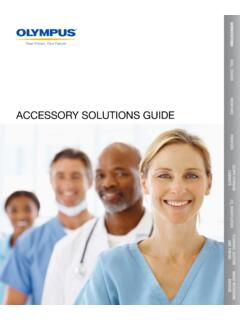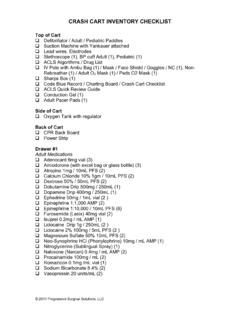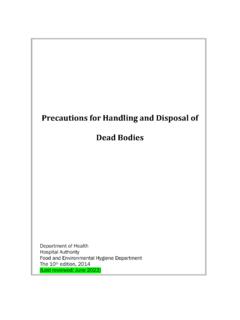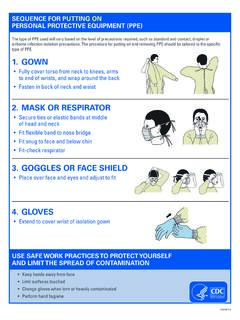Transcription of General Reprocessing Instructions for KARL STORZ Products ...
1 General Reprocessing Instructions for karl STORZ Products (USA) karl STORZ Endoscopy-America, Inc. 2151 E. Grand Avenue El Segundo, CA 90245-5071 Phone 424 218 8100 Toll Free 800 421 0837 2-03-11 Important information for users of karl STORZ instruments Please read this entire Instructions -for-use carefully before using the karl STORZ instruments. Failure to follow the Instructions , cautions and warnings presented in this manual may result in serious consequences to the patient. Procedures for proper handling and care of karl STORZ instruments are described in this Instructions -for-use. karl STORZ endoscopes and accessories are delicate surgical instruments and should be handled with care. Improper use during surgical procedures will result in damage, breakage or patient injury. karl STORZ Endoscopy-America, Inc. assumes no liability if the instruments are misused, mishandled or otherwise abused.
2 Proper handling and care, as described in this Instructions -for-use, will prolong the life of these instruments Contents Important Information 1 Why is Water Quality Important? Water quality requirements 2 Table 1 General Sterilization and High Level Disinfection Matrix 3 Table 2 Camera Heads Sterilization and High Level Disinfection Matrix 4 Pre-Cleaning Preparation 5 Cleaning Instructions for Instruments 5 - 7 Table 3 Cleaning brushes 6 Sterilization Instructions ( General introduction) 7 Ethylene oxide (EtO) Sterilization 8 - 9 Table 4 EtO Cycle Parameters 9 Steam 10 - 11 STERRAD Sterilization Systems 12 - 15 Table 5 STERRAD Sterilization Systems Lumen Claims 15 Table 6 STERRAD Tray Compatibility and Maximum Load Matrix 16 STERIS Amsco V-PRO Sterilization Systems 17 High Level Disinfection 18 - 20 Note: This document is updated frequently.
3 Please check for latest update. General Reprocessing Instructions for karl STORZ Products (USA) 2-03-11 WHY IS WATER QUALITY IMPORTANT? The quality of water used for instrument processing has a considerable influence on the proper function and longevity of an instrument. A hard layer (lime deposits, scale) can form on instruments depending on water hardness and temperature that can be very difficult to dissolve. Excessive concentrations of chlorides can also cause pitting. Cleaning solutions made up with tap water will leave mineral residues on instruments that will not wash off fully even with de-ionized water. Over time, these residues will build and could affect instrument function. The quality of the final rinsing water is a part of the hygienic standards for Reprocessing of medical devices. Rinsing water for final manual cleaning and disinfection of medical devices without following sterilization has to be absolutely free of pathogenic microorganisms.
4 When an instrument is rinsed in tap water recontamination can occur. To recap: Water quality impacts on the following: 1. Medical Devices Damage: pitting and corrosion with eventual loss of device function Reduction in cleaning efficacy Interference with high level disinfection/sterilization efficacy 2. Patient Infection transmission Adverse reaction such as inflammation and fever General characteristics to be considered for Reprocessing medical device: 1. Microbiological content of the water 2. Inorganic and organic content of the water Distilled or demineralized water is recommended for cleaning and rinsing of all instruments. General Reprocessing Instructions for karl STORZ Products (USA) 2-03-11 Table 1 Products * REFER TO Reprocessing SECTIONS FOR DETAILED Instructions * Refer to page number listed in matrix box STERILIZATION High Level Disinfection Steam Ethylene oxide gas STERRAD STERIS AutomatedManual 100S NX 100NX Amsco V-PRO STERIS Reliance EPS Medivators AER Cidex 14 Day Cidex OPA Resert XL HLD ( H2O2)
5 1 Hopkins Telescopes A X X X X X X 2 Hopkins Telescopes with Instrument Channels A X 15* X X X X 3 Semi Rigid Telescopes A X X X X X X 4 Semi Rigid Telescopes with Instrument channels A X 14* 13* X X 5 Bonfils Intubation scopes including DCI (no channel) X X X X X X 6 C-MAC 8401AX/BX/HX/AXC/BXC/KXC Intubation Laryngoscopes X X X X X X X 7 V-MAC 8401A/B/C/D/E/G Intubation Laryngoscopes # Blade only X X X# X X* 8 LED Bright Blades A X X X X X X 9 Flexible Fiberscopes X X X X X X X 10 Flexible Fiberscopes w/ no channels.
6 Ureteral stents X X X X X X X X 11 Flexible Video Endoscopes X X X 12 Flexible Video Endoscopes w/ no channels X X X X 13 Insulated/Non-insulated one piece surgical instruments X X X X X X X 14 CLICK line (insulated) or CLICK line (non-insulated) + Take-Apart Instruments (insulated) disassembled X X 15 Trocars/Cannulas/Sheaths/Obturators/Lary ngoscopes X X 15* 15* 15* X X 16 Fiber optic light cables X X X X X X X 17 Cameras (See Table 2, page 4)
7 A X X 4* 4* 4* X X 18 Powered instruments 10* X 19 Resectoscope Working Element X X 18* 18* 20 High Frequency cords A X X X X 21 Bronchoscope/Esophagoscope Tubes (light carrier off) X X X X 21 Light Carriers A X X X X X X 22 Direct Laryngoscope Handles (light carrier removed) X X X X 23 Bronchoscope/Laryngoscope Suction Tubes X X X X 24 Prismatic Light Deflectors A X X X X X X 25 Metal instrument + Lubricant + Flexible Forceps X X Approved method A: Telescopes, Prismatic Light Deflectors, and Cameras marked AUTOCLAV may be steam sterilized in pre-vacuum only, NO Flash.
8 General Reprocessing Instructions for karl STORZ Products (USA) 2-03-11 Table 2 CAMERA HEADS STERILIZATION HIGH LEVEL DISINFECTION Sterile Drape EtO Gas STERRAD (Vaporized H2O2, Plasma) STERIS CIDEX (Glutaraldehyde, ) Resert XL HLD ( H2O2) 100S (US) 100S Short Cycle (Int l) NX Standard Cycle 100NX Standard Cycle Amsco V-PRO 1 / V-PRO 1 Plus (Vaporized H2O2) Non-Autoclavable H3-Z (with blue cable nut) H3-ZI (with blue cable nut) H3-P (with blue cable nut) H3 (with blue cable nut) H3 (with black cable nut) S3 / S1 (with blue cable cylindrical ring) S3 / S1 P3 / P1 F3 D1 Telecam DCI-1/DCI-2 Tricam Autoclavable A3 /A1 H3-ZA H3-FA Telecam A/C Tricam A/C = Approved method Note: Non-soakable Cameras (22220154-3 - H3-M HD Microscope Head) Surface Disinfection Only Red Cable Nut (H3-FA, H3-ZA) Camera heads are Autoclavable.
9 Blue Cable Back Nut (H3/H3Z HD Cameras) or Cylindrical Slide Ring (S3/S1 SD Cameras) indicates validation for STERRAD NX/100NX and/or STERIS Amsco V-PRO Vapor Hydrogen Peroxide Sterilizers. Blue cable cylindrical slide ring S3 / S1 Blue cable back nutH3-Z H3H3-ZA Red cable back nut General Reprocessing Instructions for karl STORZ Products (USA) 2-03-11 WARNING: karl STORZ instruments should be thoroughly cleaned and high level disinfected or sterilized according to validated infection control procedures prior to use and subsequent reuse. CAUTION: Any deviations from the recommended parameters for cleaning and sterilization should be validated by the user. Pre-Cleaning Preparation: Place the instruments in containers and soak no longer than one hour with a neutral pH (pH to ) enzymatic cleaning solution ( , Enzol, Metrizyme, or equivalent, diluted to proper concentration per manufacturer s Instructions ) immediately after use to prevent blood, protein, and other contaminants from drying onto the instruments.
10 Wipe the instruments thoroughly with a lint-free, disposable cloth, preferably moistened with an enzymatic cleaning solution. CAUTION: DO NOT soak the telescope in any solution (including water) for longer than 60 minutes. CAUTION: DO NOT use alcohol for wipe-down of the flexible endoscope shaft. DO NOT use pushing and pulling movements to avoid damage. Water Quality Requirements: Distilled or demineralized water is recommended for cleaning and rinsing of all instruments. Cleaning Instructions for Instruments: CAUTION: WEAR PROTECTIVE GLOVES, CLOTHING, AND A FACE MASK FOR CLEANING OF CONTAMINATED INSTRUMENTS. Caution: Do not process sheaths with ceramic beaks or optical devices such as flexible endoscopes, telescopes, cameras, and light cables in an ultrasonicator. Caution: Do not soak or immerse in a liquid/chemical solution for the following instruments: Telescopes with HAMOU eyepiece drive mechanism Magnifying lenses with drive mechanism IMPERATOR handpieces Caution: Remove pressure compensation cap from flexible endoscopes before cleaning.





